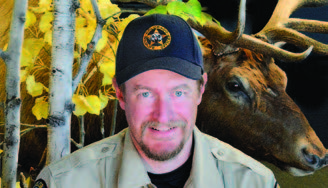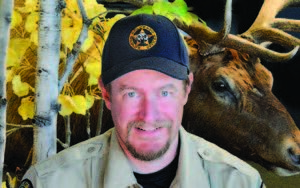
Aaron Berscheid is a district wildlife officer for Colorado Parks and Wildlife. Aaron covers the “wild” side of Northeast El Paso County, including Black Forest, Falcon, Peyton and Calhan. He also covers some of Elbert County, north of U.S. Highway 24 and south of State Highway 86, including the towns of Elbert, Kiowa, Ramah, Simla, Matheson and a small portion of the Limon area.
Learn about Mountain Lions
Consider attending CPW’s East Slope Mountain Lion Management Plan public meetings to learn more about these elusive predators.
By Aaron Berscheid
District Wildlife Manager, CPW
In recent years, videos have circulated the Black Forest community showing mountain lions wandering along trails in the region at night and even showing up in the yards of a few homes.
The popularity of home video cameras and doorbell cams has produced a lot of videos of wildlife, including mountain lions and bears.
Sometimes, we at Colorado Parks and Wildlife get asked if there are more lions than ever before. Generally, we can attribute the sightings to many more cameras catching glimpses of these typically elusive predators.
In case you are wondering, CPW biologists estimate that Colorado has an estimated mountain lion population of 3,800 to 4,400. That number does not include kittens.
Population numbers were much lower prior to 1965 before they were classified and managed as a big game species.
In fact, CPW is studying the mountain lion population living east of the Continental Divide as the agency prepares to update its mountain lion management plan.
We conducted a similar study that resulted in a new mountain lion management plan in 2020 for the Western Slope.
Want to know more? CPW will be hosting eight public meetings to provide information on the East Slope Mountain Lion Management Plan – six will be in-person meetings and two will be conducted online. By the time of this publication, there will be only two opportunities left to attend one of these meetings.
Please join us in person:
- 6-7:30 p.m., Thursday, March 7, Hillside Community Center, 925 S. Institute St., Colorado Springs, 80903
The virtual meeting is a good option for anyone who prefers to tune in from home.
Here is the schedule for the virtual meeting:
- 6-7:30 p.m., Wednesday, March 6
To join, visit: https://engagecpw.org/east-slope-lion-management-plan
Each 90-minute meeting will start with an overview of the mountain lion population on the east slope and issues facing the predator. CPW staff then will discuss goals for the management plan and a timeline for the project.
The public will then be invited to circulate among various tables where they can talk to CPW terrestrial biologists, wildlife managers and carnivore experts to learn more.
The new plan will reflect the latest science-based management practices for mountain lions.
Mountain lions in Colorado have historically been managed on smaller, localized scales — similar to the management of Colorado’s deer and elk. Current scientific research, however, shows that managing mountain lions on a broader landscape scale is more appropriate and effective.
A careful review by CPW biologists of research studies on mountain lions from Colorado, Wyoming and Montana has helped wildlife managers evaluate populations and set harvest objectives that align with the best available science.
Anyone interested in mountain lion management should attend the meetings, especially hunters, outfitters, farmers, ranchers, landowners and those who recreate in lion habitat.
When completed, the East Slope Mountain Lion Management Plan will guide future CPW biologists and wildlife managers in maintaining a stable mountain lion population east of the Continental Divide including the Front Range and eastern plains.
We hope to see you there!
For additional meeting times and locations please visit: https://engagecpw.org/east-slope-lion-management-plan
In the coming months, I’ll share more stories as I write about wildlife issues in our community: Got a question, problem or column idea, please email me at aaron.berscheid@state.co.us or call me at 719-227-5231.
I might even answer your question in a future installment of “Wildlife Matters.”




